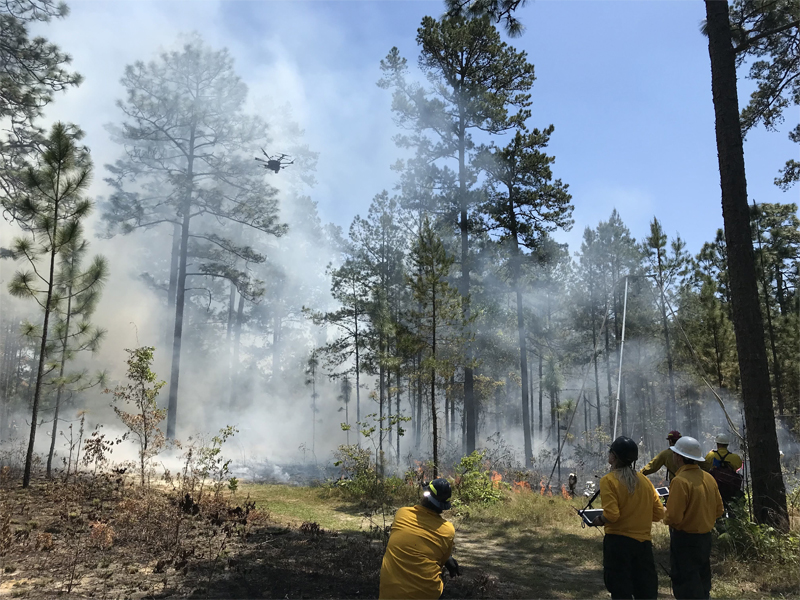- A multidisciplinary team of scientists will study how wildfire smoke spreads fungi that can affect human health, using artificial intelligence to predict future threats
- This will be the first study of its kind in a new scientific field: pyroaerobiology
- Their three-year study is funded by a $1.2 million grant from the W.M. Keck Foundation
GAINESVILLE, Fla. — As wildfire season ramps up and threatens many areas across the U.S., a team of scientists begins a multi-year study to understand how fungi spread by wildfires affect the health of people living downwind.
Their research will be the first to investigate this phenomenon.

“Based on some of our previous research, we hypothesize that fungi are hitching a ride on wildfire smoke and into the human respiratory system, causing issues ranging from Valley fever to asthma, particularly in immunocompromised individuals,” said Leda Kobziar, an associate professor of wildfire science at the University of Idaho and co-principal investigator on the research team.
Thanks to a $1.2 million dollar grant from the W.M. Keck Foundation, the five-person research team will spend the next three years establishing precisely how fungi travel via wildfire and affect human health.
“No one has studied this before. It’s a new field,” said Jason Smith, an associate professor at the University of Florida, who is leading the team.
The field is so new, the researchers had to coin a name for it: pyroaerobiology.

Using an interdisciplinary approach and the help of artificial intelligence tools, the team hopes to predict what kinds of fires and conditions pose the greatest risk for those most vulnerable to fungal infections.
“Some fungi that occur in the natural environment are able to infect people, but the question is how are fungi getting from that natural setting to where people live and breathe. Preliminary research from Dr. Kobziar’s lab indicates that wildfires may be a driver,” said Smith, who specializes in forest fungi in the UF/IFAS School of Forest, Fisheries and Geomatics Sciences.
While respiratory fungal infections are relatively rare, newer, more virulent and fungicide-resistant strains have caused concern in the medical community, Smith said.
Given the complexity of the subject, the project team includes critical expertise from three more researchers. The project team includes two medical researchers, Stephen Van Den Eeden with the Kaiser Permanente Division of Research based in Northern California, and Dr. Borna Mehrad, chief of the division of pulmonary, critical care and sleep medicine in the UF College of Medicine. The team also includes epidemiologist Karen Garrett, preeminent professor in the UF/IFAS department of plant pathology.
Each team member will head one of the project’s five aims:
Health records: Van Den Eeden will cross reference records of fungal infections in Northern California with wildfire smoke exposure over the last 12 years.
Smoke sampling: Kobziar’s lab will collect samples of smoke from wildfires and prescribed fires using drones equipped with specialized filters. At the same time, her lab will formulate models that capture how fungi are transported by counting the number of living cells in smoke.
Fungi identification: Smith’s lab will analyze smoke sampled by Kobziar’s lab to determine what fungi are present in the smoke, using culture-based and molecular methods, with special attention to those fungi known to cause fungal infections.
Animal models: Mehrad will test how smoke-borne fungi affect immunocompromised mice with the goal of understanding how the specific kinds of fungi found in smoke affect the body.
Epidemiology / artificial intelligence: Garrett will use machine learning and UF’s HiPerGator 3.0 supercomputer to integrate data from the other four aims to understand the way wildfire smoke transports fungi. The models developed will allow the researchers to predict health risks associated with a given fire.
“Machine learning provides great tools for evaluating lots of potential predictors,” Garrett said. “Since this is a new area for science, we have some basic work to do. We’ll explore the roles of many environmental and human variables to understand which are important for understanding disease risk.”
About AI at UF
The University of Florida is making artificial intelligence the centerpiece of a major, long-term initiative that is combining world-class research infrastructure, cutting-edge research, and a transformational approach to curriculum. UF is home to the most powerful university-owned supercomputer in the nation, according to rankings just released by TOP500, contributing to innovative research and education opportunities
About the W. M. Keck Foundation
The W. M. Keck Foundation was established in 1954 in Los Angeles by William Myron Keck, founder of The Superior Oil Company. One of the nation’s largest philanthropic organizations, the W. M. Keck Foundation supports outstanding science, engineering and medical research. The Foundation also supports undergraduate education and maintains a program within Southern California to support arts and culture, education, health and community service projects.
 0
0
